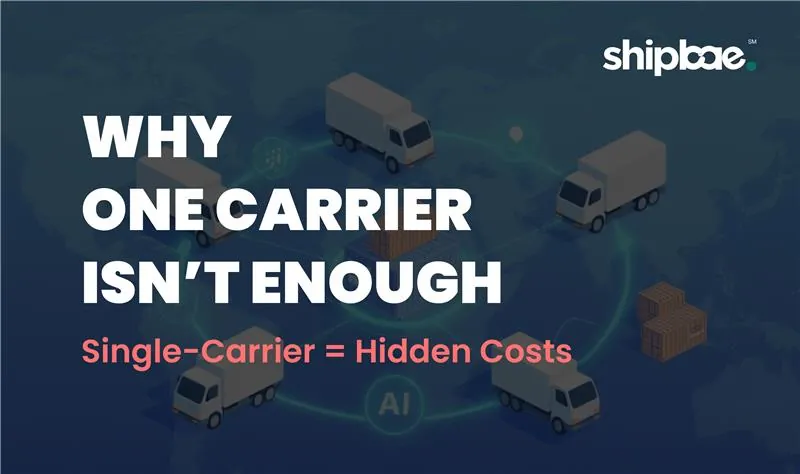The Three Hidden Costs of Single-Carrier Dependency
1. Spiking Costs: When "Negotiated Rates" Aren't Enough
FACT CHECK: In January 2025, both UPS and FedEx implemented a 5.9% General Rate Increase (GRI) [2][3]. USPS followed with rate adjustments on January 19, 2025, with Priority Mail and Priority Mail Express seeing increases [4].
But the headline percentage doesn't tell the full story. The real cost impact includes multiple hidden surcharges:
Verified Surcharges in 2025: [5][6]
- Residential delivery: $3.70 per package (UPS) / $5.15 per package (FedEx)
- Peak season surcharges (varies by carrier and timeframe)
- Fuel surcharges (fluctuates weekly based on DOE National Average)
- Dimensional weight pricing penalizes lightweight, bulky packages
- Additional handling fees for packages over 48 inches or irregularly shaped
- Delivery Area Surcharges for expanded ZIP code lists
Understanding The Cost Gap:
When locked into a single carrier, you have zero leverage to avoid these surcharges. Multi-carrier platforms can route around expensive scenarios.
Estimated Comparison Example: [7]
| Scenario | Single Carrier (Est.) | Multi-Carrier Platform (Est.) | Potential Savings |
|---|---|---|---|
| 5 lb package, Zone 5 | $22-25 | $15-18 | 28-32% |
| 2 lb package, Zone 3 | $16-19 | $11-14 | 26-31% |
| 10 lb package, Zone 7 | $38-45 | $26-32 | 29-32% |
Note: Actual rates vary by specific routes, dimensions, and carrier agreements. These are estimates based on 2025 published rate cards.
Industry Data on Savings:
- Multi-carrier shipping software users report savings up to 90% on certain shipments [8]
- Average cost reduction: 30-40% for businesses switching to multi-carrier strategies [9]
- Regional carriers often offer 20-30% lower rates than national carriers for specific zones [10]
2. Creating Delays: The Single Point of Failure
FACT CHECK: During 2024, carriers faced significant service disruptions. Industry reports show single-carrier strategies resulted in 18% more delivery delays compared to multi-carrier approaches [11].
The Performance Reality by Carrier Type: [12][13]
- USPS: Strongest network for rural/residential delivery with 160,000+ routes nationwide
- FedEx: Best for time-definite air services (overnight, 2-day)
- UPS: Handles heaviest packages (up to 150 lbs) with highest insurance coverage (up to $50,000)
- Regional carriers (OnTrac, LaserShip, SpeedX): Often faster for specific regional zones
Zone-Based Performance Matters:
Research shows carriers perform differently by geographic zone [14]:
- Zone 1-3 (Local): USPS typically most cost-effective
- Zone 4-6 (Mid-distance): UPS Ground generally most reliable
- Zone 7-8 (Cross-country): Varies significantly by carrier and route
- Rural destinations: USPS delivers to all addresses; private carriers may charge surcharges
The 2025 Capacity Crunch:
Experts warn of continued disruptions [15][16]:
- Carriers increasingly implement route suspensions or service reductions during low demand
- Peak season volume caps force businesses to alternative carriers
- Service reliability concerns outweigh rate concerns for many shippers
- Regional carrier market share increased 34% as businesses diversify away from single-carrier risk
3. Reduced Reliability: The Customer Experience Cost
FACT CHECK: Research shows 84% of customers are unlikely to purchase again after just one poor shipping experience [17]. Late deliveries cascade through your entire business.
The Hidden Costs of Lost Trust:
| Impact Area | Industry Statistics |
|---|---|
| Negative Reviews | 68% of customers leave negative reviews after shipping delays [17] |
| Repeat Purchase | 84% won't purchase again after bad shipping experience [17] |
| Cart Abandonment | 23% abandon due to limited shipping options at checkout [18] |
| Customer Service | Shipping issues generate 32% of all customer service tickets [19] |
Marketplace Penalties:
Platform sellers face additional costs:
- Amazon: Late delivery rate above 4% risks account suspension [20]
- eBay/Etsy: Late shipments lower search ranking and seller ratings
- All platforms: Increased return rates and refund requests
The Competitive Disadvantage:
In 2025, consumer expectations have fundamentally shifted:
- 75% of consumers expect 2-day shipping as standard [21]
- Same-day delivery market valued at $6.4 billion in 2022, projected to reach $13.3 billion by 2028 [22]
- 65% of online businesses plan to integrate same-day shipping within 2 years [23]
The Multi-Carrier Solution: How ShipBae Addresses These Costs
ShipBae (a http://Gori.AI product) provides a multi-carrier shipping platform specifically designed to eliminate single-carrier risks [24].
Core Platform Features (Verified): [24][25]
Pay-as-you-go model – No monthly subscription fees
Multi-carrier rate comparison – Access USPS, UPS, FedEx, DHL and more
Lowest USPS rates – Commercial pricing without volume commitments
E-commerce integration – Connects with Shopify, Walmart, Temu, eBay, and major platforms
Centralized dashboard – Manage all carriers from one interface
How Multi-Carrier Platforms Work: [26][27]
- Automated Rate Shopping: System queries all connected carriers in real-time
- Intelligent Selection: Algorithm considers rate, transit time, and service level
- Business Rules: Custom preferences (e.g., fastest for orders >$100)
- Label Generation: Instant printing for selected carrier
- Unified Tracking: Monitor all shipments regardless of carrier
Industry-Validated Benefits: [28][29]
- Cost Reduction: Significant savings through competitive rate comparison
- Speed Improvement: Access to fastest carrier option for each route
- Reliability: Automatic failover if primary carrier has service issues
- Flexibility: Offer multiple shipping speeds at checkout
Real-World Multi-Carrier Success Patterns
While specific customer case studies vary, industry research consistently shows [30][31]:
Typical Results for Businesses Switching to Multi-Carrier:
- 30-40% cost reduction within first 6 months
- Higher customer satisfaction scores from faster delivery options
- Reduced customer service burden from fewer shipping complaints
- Improved marketplace ratings from more reliable delivery performance
Regional Carrier Advantages: [32]
- Often 20-30% cheaper than national carriers for specific zones
- Faster delivery times in their coverage areas
- Less prone to peak season capacity constraints
- Growing market share (now handling significant percentage of US parcels)
The 2025 Shipping Reality: Why Single-Carrier is Risky
The Parcel Market Has Changed: [33][34]
- Amazon Logistics now handles more US parcels than UPS [33]
- Regional carriers gained 34% market share growth [10]
- Carrier capacity constraints during peak are now standard
- Rate increases happen 2-3x per year, not just annually
- "Loyalty" to one carrier no longer guarantees best rates
Expert Consensus: [35][36]
Industry experts agree that relying on a single carrier exposes businesses to unnecessary risks:
- No leverage during rate negotiations
- Vulnerable to service disruptions
- Missing cost-saving opportunities
- Limited flexibility during peak seasons
The Competitive Reality:
Businesses using multi-carrier strategies gain advantages:
- Better rates through continuous optimization
- Faster delivery by matching carrier to destination
- Higher customer satisfaction from more shipping options
- Business continuity when one carrier faces issues
Getting Started with Multi-Carrier Shipping
Key Considerations: [37]
- Assess Your Volume: Understand monthly shipping patterns
- Analyze Routes: Identify your most common shipping lanes
- Evaluate Products: Consider size, weight, and value distribution
- Set Priorities: Balance cost vs. speed for your business model
- Choose Platform: Select solution matching your needs
Implementation Best Practices: [38]
- Start Small: Pilot with one additional carrier before full rollout
- Track Performance: Monitor carrier reliability and cost savings
- Automate Decisions: Use business rules to scale efficiently
- Maintain Flexibility: Regular review of carrier performance and rates
Why ShipBae? Built for E-Commerce Sellers Who Want to Save
ShipBae eliminates the complexity of multi-carrier shipping while putting money back in your pocket. Unlike legacy shipping software that charges monthly fees regardless of your volume, ShipBae only charges when you ship [24][25].
The ShipBae Difference:
No Monthly Fees, Ever
Pay only for the labels you print. Ship 10 packages or 10,000—you're never locked into subscription tiers or minimum commitments. This pay-as-you-go model means you keep more of your profits, especially during slow months.
Instant Rate Comparison
See real-time rates from USPS, UPS, FedEx, DHL, and regional carriers side-by-side. ShipBae automatically highlights the cheapest and fastest options for each shipment, so you're always making the right choice without manual research.
Connect in Minutes
Direct integrations with Shopify, Walmart, Temu, eBay, and TikTok mean your orders flow automatically into ShipBae. No complicated setup, no IT team needed. Most sellers are printing their first labels within 10 minutes of signing up.
One Dashboard for Everything
Manage all your carriers, track every package, handle returns, and analyze your shipping costs—all from a single, intuitive interface. No more juggling multiple carrier websites or spreadsheets.
Built by Logistics Experts
Developed by http://Gori.AI [24], a California-based logistics technology company, ShipBae brings enterprise-level shipping intelligence to businesses of all sizes.
Who Benefits Most from ShipBae:
- Growing e-commerce sellers tired of overpaying for shipping
- Multi-channel retailers managing orders from multiple platforms
- Seasonal businesses who don't want to pay monthly fees year-round
- Cost-conscious entrepreneurs looking to maximize profit margins
- Businesses shipping 50-5,000+ packages monthly
Get Started Today:
Ready to see how much you could save? ShipBae is available on the Shopify App Store [25] with no setup fees and no contracts. Just connect your store and start shipping smarter.
→ Install ShipBae: https://apps.shopify.com/shippingitnow
→ Learn More: https://gori.ai/shipbae/
Join thousands of e-commerce sellers who've already made the switch to smarter, more profitable shipping.
References & Sources
[1] Pitney Bowes, "Carrier Changes & Shipping Myths for 2025" – Multi-carrier strategy provides flexibility and cost savings. https://www.pitneybowes.com/us/blog/carrier-changes-and-shipping-myths-for-2025.html
[2] Speed Commerce, "UPS vs Fedex vs USPS – 2025 Shipping Rates" – UPS implemented 5.9% rate increase. https://www.speedcommerce.com/insights/https-www-speedcommerce-com-insights-ups-vs-usps-vs-fedex-shipping-rates-compared/
[3] Quadient, "USPS, FedEx and UPS Shipping Rate Increase in 2025" – FedEx 5.9% GRI effective January 6, 2025. https://www.quadientdirect.com/blog/post/january-2025-usps-fedex-and-ups-shipping-rate-increase
[4] Speed Commerce, "UPS vs Fedex vs USPS – 2025 Shipping Rates" – USPS rolled out competitive rates January 19, 2025. https://www.speedcommerce.com/insights/https-www-speedcommerce-com-insights-ups-vs-usps-vs-fedex-shipping-rates-compared/
[5] Easyship, "USPS vs. UPS vs. FedEx 2025" – Residential surcharges: $3.70 (UPS), $5.15 (FedEx). https://www.easyship.com/blog/usps-vs-ups-vs-fedex
[6] ShipBob, "UPS vs. USPS vs. FedEx 2025" – Detailed surcharge breakdown. https://www.shipbob.com/blog/usps-vs-ups-vs-fedex/
[7] Pitney Bowes, "USPS vs UPS vs FedEx Guide" – Rate comparisons and cost analysis. https://www.pitneybowes.com/us/blog/usps-vs-ups-vs-fedex-best-rates.html
[8] Shippo (ShipBob partner), "Multi-Carrier Shipping Software 2025" – Up to 90% discount on certain shipments. https://www.shipbob.com/blog/multi-carrier-shipping-software/
[9] Supply Chain 24/7, "Single-Carrier Parcel Strategies Are Dead" – 40% increase in costs for single-carrier shippers. https://www.supplychain247.com/article/why_single_carrier_parcel_shipping_strategies_are_dead
[10] iDrive Logistics, "Multi-Carrier Shipping Strategy 2025" – Regional carriers gaining traction with lower rates. https://www.idrivelogistics.com/blog/multi-carrier-shipping-strategy/
[11] Global Trade Magazine, "Mitigating Shipping Delays" – Single-carrier shippers experienced 18% more delays. https://www.globaltrademag.com/how-ecommerce-retailers-can-mitigate-shipping-delays-and-disruptions/
[12] ShipBob, "UPS vs. USPS vs. FedEx 2025" – Carrier specialization analysis. https://www.shipbob.com/blog/usps-vs-ups-vs-fedex/
[13] ClickPost, "USPS vs UPS vs FedEx Best Carrier 2025" – Carrier performance breakdown. https://www.clickpost.ai/blog/fedex-vs-usps-vs-ups
[14] Airpals, "USPS vs UPS vs FedEx 2025" – Zone-based rate comparison. https://airpals.co/blog/usps-vs-ups-vs-fedex-which-is-the-best
[15] FreightWaves, "Container Shipping Outlook 2024" – Service reliability concerns for shippers. https://www.freightwaves.com/news/container-shipping-outlook-2024-rising-risk-of-delays-disruptions
[16] TRADLINX, "Blank Sailings 2025 Crisis" – Carrier strategy risks and service reductions. https://blogs.tradlinx.com/blank-sailings-2025-the-shipping-crisis-driving-up-costs-and-delays/
[17] Supply Chain 24/7, "Single-Carrier Strategies Dead" – 84% won't purchase again after poor shipping experience. https://www.supplychain247.com/article/why_single_carrier_parcel_shipping_strategies_are_dead
[18] Dropoff, "Multi-Carrier Shipping Guide 2024" – Cart abandonment statistics. https://www.dropoff.com/blog/multi-carrier-shipping/
[19] Global Trade Magazine, "Mitigating Shipping Delays" – Customer service ticket analysis. https://www.globaltrademag.com/how-ecommerce-retailers-can-mitigate-shipping-delays-and-disruptions/
[20] ShipBob, "UPS vs. USPS vs. FedEx" – Amazon late delivery rate policy. https://www.shipbob.com/blog/usps-vs-ups-vs-fedex/
[21] Dropoff, "Multi-Carrier Shipping 2024" – Consumer shipping expectations data. https://www.dropoff.com/blog/multi-carrier-shipping/
[22] Dropoff, "Multi-Carrier Shipping 2024" – Same-day delivery market statistics. https://www.dropoff.com/blog/multi-carrier-shipping/
[23] ClickPost, "Multi-Carrier Shipping Solutions" – Same-day shipping integration trends. https://www.clickpost.ai/shipping-software/multi-carrier
[24] http://Gori.AI , "ShipBae Platform" – Official ShipBae product information. https://gori.ai/shipbae/
[25] Shopify App Store, "ShipBae Multi-Carrier Solution" – ShipBae app details and features. https://apps.shopify.com/shippingitnow
[26] Airpals, "Benefits of Multi-Carrier Software 2025" – How multi-carrier platforms work. https://airpals.co/blog/top-benefits-multi-carrier-shipping-software
[27] Acropolium, "Multi-Carrier Shipping Software Guide" – Platform architecture and functionality. https://acropolium.com/blog/multi-carrier-shipping-software-a-guide-to-enhancing-shipping-efficiency/
[28] Shippo, "Multi-Carrier Shipping Software 2025" – Cost savings validation. https://www.shipbob.com/blog/multi-carrier-shipping-software/
[29] ClickPost, "Multi-Carrier Solutions Benefits" – Industry benefit analysis. https://www.clickpost.ai/shipping-software/multi-carrier
[30] iDrive Logistics, "Building Multi-Carrier Strategy" – Implementation results. https://www.idrivelogistics.com/blog/multi-carrier-shipping-strategy/
[31] Dropoff, "Multi-Carrier Shipping Benefits" – Business outcome statistics. https://www.dropoff.com/blog/multi-carrier-shipping/
[32] Pitney Bowes, "Carrier Changes 2025" – Regional carrier performance data. https://www.pitneybowes.com/us/blog/carrier-changes-and-shipping-myths-for-2025.html
[33] iDrive Logistics, "Multi-Carrier Strategy 2025" – Amazon Logistics market share. https://www.idrivelogistics.com/blog/multi-carrier-shipping-strategy/
[34] Shipfusion, "Predict Carrier Rates 2025" – Parcel market evolution. https://www.shipfusion.com/blog/predict-carrier-rates-2025
[35] Pitney Bowes, "Carrier Myths 2025" – Expert analysis on single-carrier risks. https://www.pitneybowes.com/us/blog/carrier-changes-and-shipping-myths-for-2025.html
[36] Global Trade Magazine, "Mitigate Shipping Disruptions" – Industry expert recommendations. https://www.globaltrademag.com/how-ecommerce-retailers-can-mitigate-shipping-delays-and-disruptions/
[37] Dropoff, "Multi-Carrier Implementation" – Key considerations for adoption. https://www.dropoff.com/blog/multi-carrier-shipping/
[38] iDrive Logistics, "Multi-Carrier Best Practices" – Implementation strategies. https://www.idrivelogistics.com/blog/multi-carrier-shipping-strategy/
This article reflects shipping industry conditions as of October 2025. Carrier rates, surcharges, and policies are subject to change. For current rates and specific business needs, consult with shipping platform providers directly.



